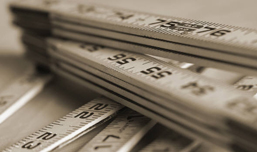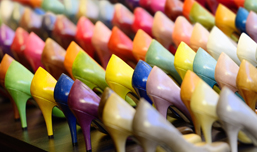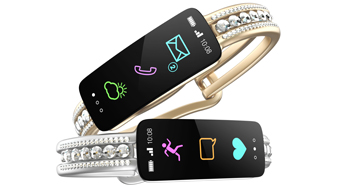Smart couture
In the fashion industry, wearable technology is so hot right now. It’s the place where fashion and technology meet, generating myriad new concepts, designs and products. From belts, glasses and watches to jackets, shoes and dresses, everything that can be worn is getting the high-tech treatment.
Visitors to the FashionWare show at the Consumer Electronics Show (CES) in Las Vegas this January saw an array of new designs, such as British designer Rainbow Winter's photochromic-ink dresses, which change colour when exposed to UV light
At Wired 2014, Will.i.am, in collaboration with architect Zaha Hadid, launched PULS, a 'cuff' that enables the user to make calls without the aid of their smartphone. Tommy Hilfiger's new solar-powered jacket charges the wearer's phone on the go, and Richard Nicoll's new collection includes a fibre-optic dress that produces dazzling designs. Ralph Lauren debuted a tech-infused tennis shirt at the US Open last year, which monitored the ball boys' heart rates and stress levels.
Given the interest in this area over the last twelve months, it's not surprising that the market for fashion wearables is forecast to explode over the next couple of years. Analysts at Gartner predict the smart garment market alone will grow rapidly, from 0.1 million units shipped worldwide in 2014 to 26 million in 2016. To put this in perspective, however, global smartphone shipments in 2014 were well over one billion units.
 Fashion wearables are still in the experimental stage. As with haute couture, the appeal of these products is limited to a select few – for now at least – and we're most likely to see this smart couture at runway shows or in concept stores. Early adopters tend to be those in the public eye – like Lady Gaga – or those who can afford the latest designs and are prepared to make a bold fashion statement. Of course, the fashion industry works by designers setting trends for the rest to follow. In the case of wearables, however, the avant-garde is yet to cross over to the mainstream.
Fashion wearables are still in the experimental stage. As with haute couture, the appeal of these products is limited to a select few – for now at least – and we're most likely to see this smart couture at runway shows or in concept stores. Early adopters tend to be those in the public eye – like Lady Gaga – or those who can afford the latest designs and are prepared to make a bold fashion statement. Of course, the fashion industry works by designers setting trends for the rest to follow. In the case of wearables, however, the avant-garde is yet to cross over to the mainstream.
The average fashion consumer makes a number of conscious and subconscious decisions before making a purchase. Those creating fashion wearables need to take all of these into account during the design process:
Does it look good?
For most people, what they wear is a fashion statement in some way, so – seen in this light – many wearables are inherently fashion items. Research by the NPD Group found that 51% of consumers, who are interested in buying a smartwatch, would only consider it if it fits with their personal style. Industry commentators at Beecham Research also say that how these gadgets look is critical to their success.
Producing items that appeal to the mainstream is, of course, not easy given that style is unique to each individual. Recent news that Google Glass is no longer for sale is testimony to this: aside from the privacy issues that dogged this product, many people were evidently put off by its techie look.
Some experts go so far as to assert that the input of fashion designers may be essential to the future of this technology category as a whole. Technology companies, such as Apple, have acted on this notion, and turned to the fashion industry to help ensure their wearable products are as appealing as possible.
This has led some people to view the Apple Watch as the first potentially mainstream fashion wearable – perhaps even bringing wearable technology to more people than any other gadget has so far has been able to do. Fashion writer, Madeleine King, outlines a key reason for this predicted appeal: "It's not that the Apple Watch really offers much more [than other smartwatches] in terms of functionality, but that the watch itself is a much more versatile fashion accessory."
 Does it fit?
Does it fit?
One criticism of current wearables, especially for women's fashion, is that they are simply too big. Integrating smart technology into watches or jewellery, for instance, without making the items bulky and ugly, is a major technical and design challenge.
Advances in technology, coupled with ongoing experimentation, are, however, producing more elegant devices. For example, US startup, Ringly, has created a smart ring that features four different colours of semiprecious stones and is plated with 18K gold. It notifies the user of a ring, text, email or social media notification by different vibrations and blinking lights. This approach seems to be paying off: the first thousand rings sold within 24 hours and the company received US$5.1 million in additional funding this month.
Do I want to pay this much for it?
Another challenge for fashion wearables is commoditisation. Margins for mainstream fashion are slim, so mass market items need to be relatively cheap to manufacture and supply. Even luxury products with a premium price tag will need to overcome this hurdle if they are to sell in significant numbers.
New technology and designs will no doubt reduce manufacturing costs as time goes by. Yet the cost problem is compounded by the mercurial nature of fashion, which also raises questions about price points and target markets. Will the item be versatile and 'timeless' enough to be worn as styles change over the seasons, or will it be disposable – cast off like last autumn's clothes?
Would I use it?
It's clear that smart couture needs to become both more fashionable and more useful to appeal to the mass market. As Forbes journalist, Rachel Arthur, says: "when it's the norm that designers take to New York Fashion Week and show pieces that are both aesthetically pleasing and genuinely provide a practical solution that consumers always want to wear, that will be the season to take note."
 Fashion consumers often buy something knowing they'll only use it a few times (and those in the public eye are often slated for wearing something more than once). But in the wearables space, utility is key. Unless prices drop dramatically, consumers will need to be convinced that these items will not only fit their style but also enhance their life in some way.
Fashion consumers often buy something knowing they'll only use it a few times (and those in the public eye are often slated for wearing something more than once). But in the wearables space, utility is key. Unless prices drop dramatically, consumers will need to be convinced that these items will not only fit their style but also enhance their life in some way.
To date, the blending of fashion and technology has – in many cases – been far from seamless. This has led to niche products that are seen as unfashionable (or too avant-garde), too big, too costly or too techie. If wearable products are being positioned or perceived as fashion items (as opposed to purely functional health tech devices, for example), it's clear that brands will need to think about style as well as functionality in order to achieve commercial success.
If you have any questions on this article please contact us.


Louise Taylor
Louise looks at the growing credibility of wearables as fashion items.
"Fashion wearables are still in the experimental state … consumers need to be convinced that these items will not only fit their style but also enhance their life in some way."

